JVC DLA-NZ8 Reviewed at $15,999.00
Product Name: JVC DLA-NZ8
Product Description: 8K D-ILA Projector
-
Design - 9.5/10
9.5/10
-
Video Quality - 9.6/10
9.6/10
-
Ports & Connectivity - 9.4/10
9.4/10
-
OS, Apps and Features - 9.5/10
9.5/10
-
Price / Quality - 8.9/10
8.9/10
Summary
Reviewed at $15,999.00
Pros
- Laser light source
- Amazing image quality and black levels
- Great HDR support
- HDMI 2.1 ports
Cons
- Brightness takes a hit with cinema filter enabled
- Slightly louder than we like
- Missing some HDMI 2.1 gaming features
- Very expensive for most
Cheapest Places to Buy :
*We are a reader-supported website. When you buy through links on our site, we may earn a small affiliate commission at no extra cost to you. Home Media Entertainment does not accept money for reviews.*
Today we make a return to JVC projectors after our previous testing of their excellent DLA-NZ7 and we will be looking at the mid-tier unit, if you can call it that, in their latest 2022 release lineup. If you are a projector enthusiast then JVC is probably in your radar and not without reason. Their previous NX lineup was simply amazing and JVC seems to have gone a step further this year. So in our JVC DLA-NZ8 review we are going to put this monster through its paces to see what it is made of.
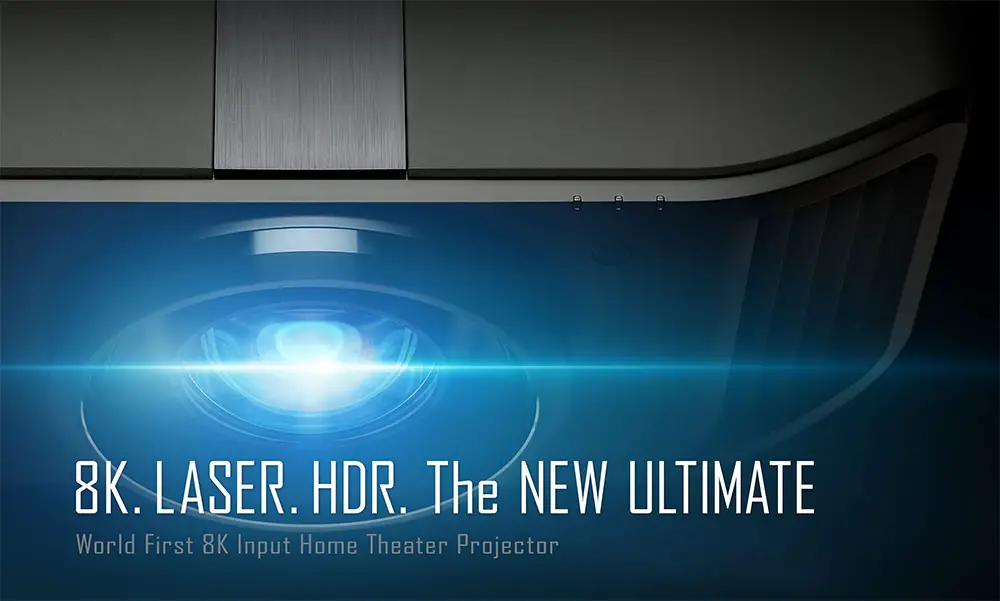
The new 2022 lineup consists of three projectors including the DLA-NZ7 we previously tested, the DLA-NZ8 we have here with us today and the top of the line DLA-NZ9. Along with these three the previous DLA-NX5 will still remain part of the new lineup as a more low budget solution. The biggest difference this year is centered around two things. First of all the new lineup can support up to 8K and that the new projectors have changed from lamp based to laser based. So while in many aspects the new models may look similar to their predecessors there are some fundamental differences between them.
The DLA-NZ8 has a few notable upgrades over the NZ7 so let’s see real quick what this JVC projector has to offer. The NZ8 can accept up to 8K@60Hz signals and output 8K with e-shiftX technology which is an upgrade over the e-shift technology of the NZ7. It uses JVC’s third generation BLU-Escent laser diode light source capable of 2,500 lumens of brightness along with a 3-chip design, one for each primary color. It is rated at 80.000:1 native contrast, supports HDR, HDR10+ and Wide Color Gamut and it can display 3D with the use of an optional dongle.
What we have here is a $16,000 monster of a projector and surely if you are going to pay such an amount you have a lot of expectations. Does JVC manages to exceed them or its price tag is far too high for what you get? Keep reading to find out…
Design
As we always do with JVC projectors, we need to clear up some confusion regarding their naming, in case you were wondering. JVC has two separate divisions with one being the JVC consumer division and the other being the JVC Pro division. Both these divisions release the same projector models but with different naming. So the Consumer versions are the DLA-NZ7, DLA-NZ8 and DLA-NZ9 while their Pro variants are the DLA-RS2100, DLA-RS3100 and RS-4100.
There is no difference whatsoever between these models in their hardware and the only way you can tell them apart is what seems to be a gold trim ring around the lens as the consumer version comes with a silver one instead. Having the same hardware means that pricing shouldn’t differ at all so if you find both of them at different prices we recommend you to go for the lower one.
This is something that JVC is doing for a few good years now and many people are asking what the difference between them are. There is none whatsoever and we strongly advise JVC to find a solution to this as it adds far more confusion to their consumers than it should.
Looks and Ventilation
As for its design the DLA-NZ8 is no different in size of form from the NZ7. In fact the only two minor elements that give it away is the 8K/eShiftX logo and the slightly higher weight of the NZ8. Everything else is like for like to the NZ7.
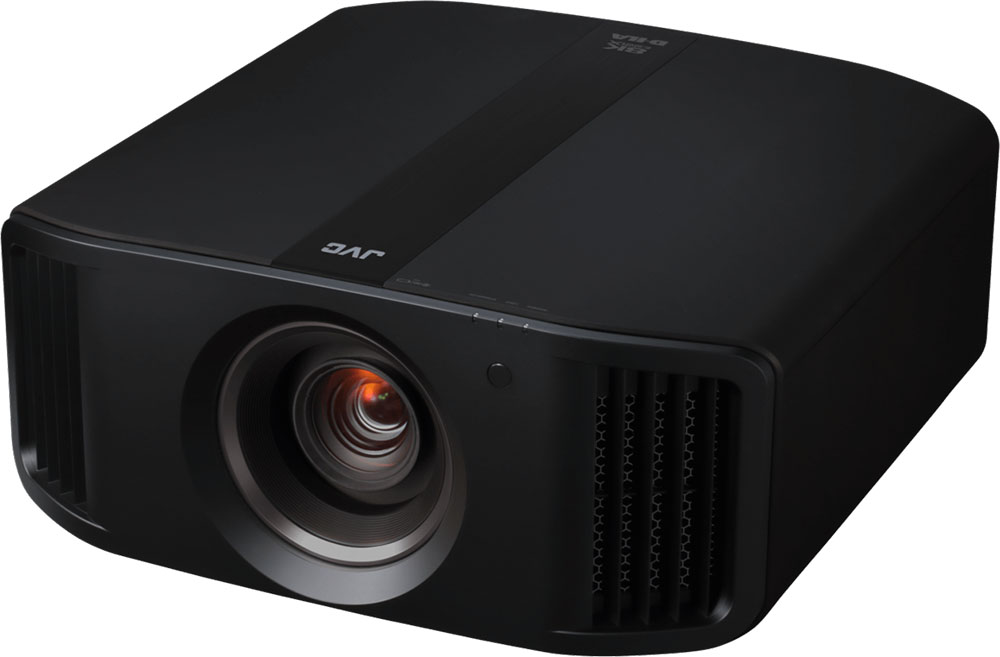
In terms of size the NZ8 is a small monster and is one of the biggest projectors we have tested so far. Measuring 9-11/16 x 9-7/32 x 19-29/32 (500 x 234 x 505 mm) including the feet and with a weight of 51.0 lbs (23.1 kg) the NZ8 should be handled with extreme care when being placed as it needs ample of room not only because of its size but also in order to have good ventilation.
The unit features a rather simple look with a black boxy design with curvy corners and a matte black finish and our impressions of it remain the same as was for both the previous NX lineup and for the NZ7. It looks good without going overboard. The front face keeps the lens dead center with an IR sensor visible just above and to the right of it.
In both front corners we get two huge air vents but as was the case in the NZ7 we didn’t notice any noteworthy light leakage. Exactly at the corner above the IR sensor we find three indicator lights while the top face features a simple black strip in the middle with some logos on it and nothing else.
The back of the unit is also exactly the same and here we get two big air inlets with filter covers. Above the right air inlet we get a second IR sensor that is handy when placing the projector on a furniture in front of you as well as the built-in controls that include a power button, menu, navigation buttons and a back function. On the left side of the control buttons we get all the connections of the unit which we will analyze in the appropriate section while all four legs feature adjustable screws in order to level the projector accordingly.
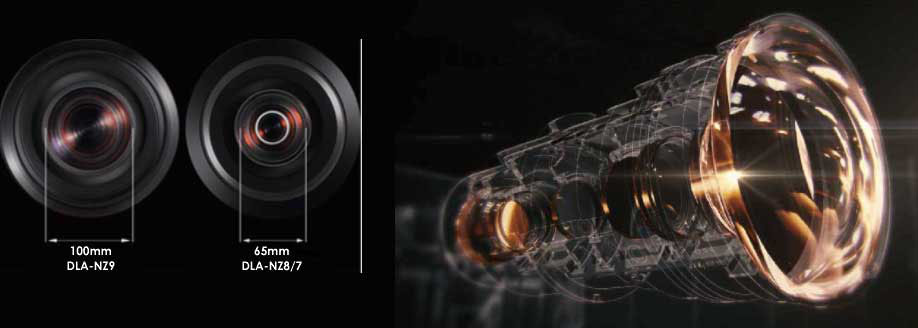
Lens Specs
JVC always used great optics in their projectors and the new NZ lineup could not use anything less. The NZ8 use the same we saw in the NZ7, as only the NZ9 uses a better variant, with a 17-element, 15-group all-glass 65mm diameter high-quality motorized lens that JVC designed to deliver exceptionally clear images. The lens comes with a 2x zoom and a great ±80% vertical and ±34% horizontal lens shift which can be very handy when placing the projector and calibrating it.
Having such a big size lens shift can really make a difference and with such a huge projector that is not easily handled this will surely be appreciated. As was the case with the previous lineup, if there is one thing we would like to see is a motorized lens cover. It’s a shame to have such a premium projector with such an extremely high quality optic system that you have to cover all the time with a plastic cover by hand.
Noise Levels
When it comes to noise the DLA-NZ8 is rated by JVC at 24dB in Low mode which of course is a theoretical number and is based on specific lab conditions. In our case we had the projector at a distance of around 6 feet (2 meters) and the DLA-NZ8 was producing around 37db in Low mode. This figure would go up to around 44db in High mode.
The NZ8 was definitely louder than its smaller brother, the NZ7. Obviously there are many factors at play when it comes to noise but the projector was slightly louder than what we would like. But this has to do with how sensitive you are to such noise so many people may not be bothered by it at all.
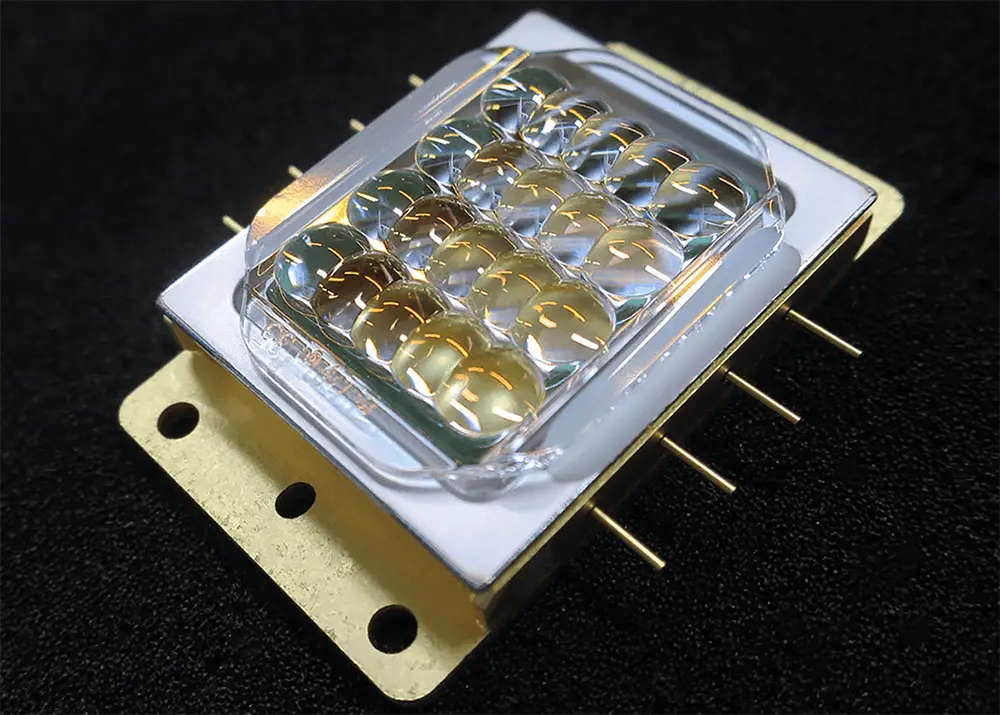
Light Source Hours
Although the NZ series have many characteristics of the previous NX projectors the most obvious change was that the new NZ8 uses JVC’s third-generation BLU-Escent module with a blue laser diode array and yellow phosphor wheel to generate the red, green, and blue signals. This gives the projector a life of about 20,000 hours which averages to about 4 hours of daily use for 14 years which is great by any standards.
Remote
The remote that is included with the NZ8 is exactly the same one we used in the NZ7 along with the previous NX series and is code named RM-MH27. It has a nice premium look and is very easy to handle as the size is just about right. Buttons size is good although there is no space between them which can result in accidentally pushing the wrong one instead.
But the major plus is the included backlight function that illuminates the button’s writing instead of the whole buttons and this can majorly help when using the remote in the dark. Hopefully at some point JVC will incorporate motion sensitive backlight which is an amazing feature as we had first seen in the Sony A90J TV remote. For such a premium projector there is no excuse not to have something similar.
There are no built-in speakers here but this should not be considered a minus as the projector is not meant to be mobile friendly like some other releases. Its huge size and weight makes it a place and forget projector. As was with the NX lineup, the new NZ series is meant to be placed in a home theater room and stay there, not moving it around all the time.

The JVC DLA-NZ8 is a premium projector and it shows. JVC made sure to use only the best materials and hardware and it’s an impressive projector no matter how you see it.
Video Quality
Technology used
The NZ8 comes with a lot of the same technologies that were included in the NZ7 but there is a notable distinction between the two.
Keep in mind that JVC advertises the entire NZ series, along with the NZ8, as 8K capable projectors because of the fact that these can accept up to 8K@60Hz signals. What is really interesting is its output as JVC’s previous two-phase/120 Hz e-shift technology that was exclusive to the previous DLA-NX9 now has found its way down to the NZ7.
On the other hand the new NZ8, along with JVC’s top tier NZ9, uses the new 8K e-shiftX technology which operates at 240Hz instead of the 120Hz of the standard 8K e-shift. Pixel shift direction has increased from the conventional two diagonal directions to four directions of up, down, left, and right, to enable display of the full 8K signal information in its entirety.
So just to make things clear, the less capable 8K/e-shift technology only doubles the 4K signal while the new 8K-e-shiftX quadruples it essentially showing the full 8K signal as it should.

Once again we find three of JVC’s latest generation 0.69 inch D-ILA chips that are responsible for displaying a full 4K resolution image. What is worth noting, that was also noticeable in the NZ7, is that as most 4K UHD content is rendered at 3840 x 2160 resolution the NZ8 will display black bars on the right and left sides of the screen which can be a bit distracting. So if you want to take these out of the screen you will need to calibrate the image accordingly.
The NZ8 comes with many of the same features that we found in the NZ7 which means that we once again get great overall lens controls. Also its Frame Adapt auto tone mapping and Theater Optimizer, that were introduced in the previous series after an update, automatically adjust settings based on the mastering information included in HDR content and thus offers better overall brightness and image quality even for individual user customizations.
4K UHD / HDR Content
For this projector review we decided to go with Pacific Rim: Uprising in 4K UHD as the film has an extremely high resolution and colorful look which is ideal for testing any projector’s abilities.
From the first seconds the NZ8 really showed why it is such a highly priced projector. It was not only the sharp 4K images and overall high resolution of the picture that were impressive but the colors, specular highlights and deep blacks were so good that all together made the image have such an immersive and highly cinematic feeling to it.
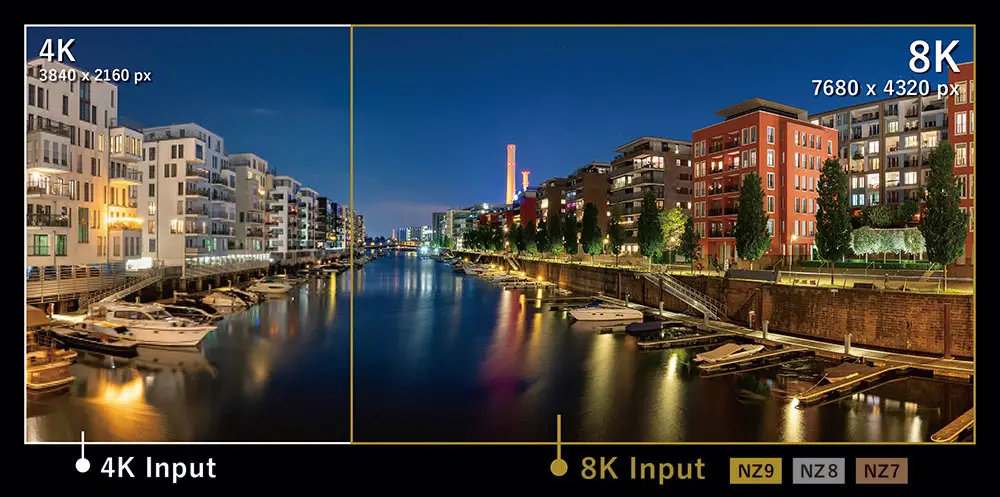
The NZ8, and in general the whole JVC NZ series, is on a completely different level from these low cost DLP projectors and this couldn’t be different as the price difference is simply huge.
When it comes to the NZ8’s HDR capabilities there are a few differences, or rather say improvements, compared to the previous generation. We find support for HDR10 which is the basic protocol for UHD playback as well as HLG that is used mostly for broadcasting but this time JVC has added HDR10+ making the NZ lineup one of the first to support it.
One major feature that makes a return is the inclusion of Auto Tone Mapping. We had previously seen this one in the NX lineup so we knew more or less what to expect from it. But in the new NZ projectors JVC went a step further and added a second mode called Frame Adapt, which we got some first hands experience during our NZ7 testing.
What Auto Tone Mapping basically does is to read the static HDR metadata of a UHD disc and adjust the image settings of the projector according to the max and average light settings of the content being displayed. This way the end image that we see is better as it is tailored to the projector’s capabilities.
The Auto Tone Mapping is an amazing feature and it can really produce very good results if you take into account the limited brightness capabilities of the projector in general. But what the Auto Tone Mapping feature doesn’t do is any kind of dynamic tone mapping but instead gives you some short of manual control with the inclusion of a 11-step mapping level slider (-5 to 5).
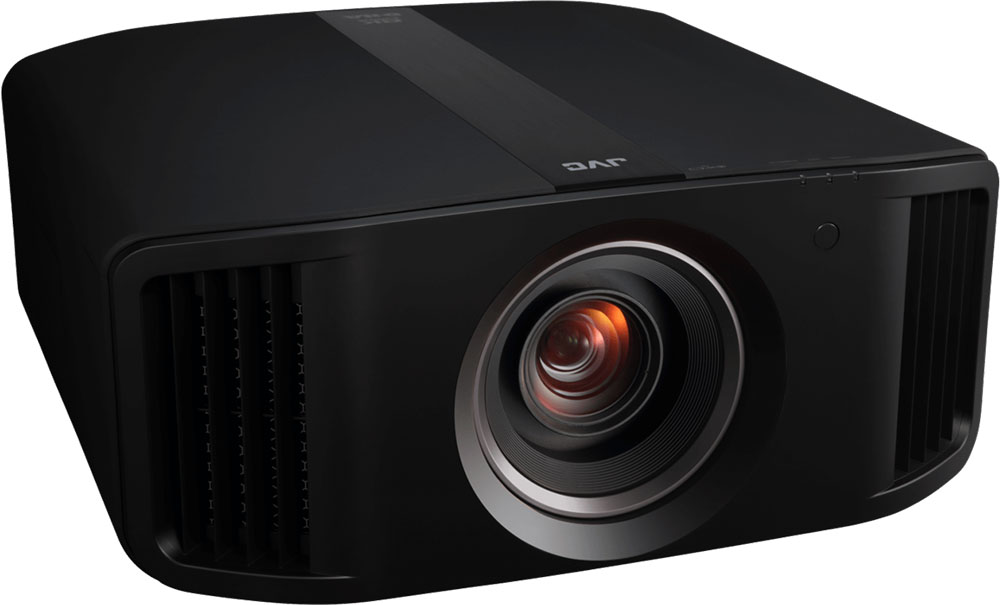
On the other hand the new Frame Adapt HDR option allows the projector to dynamically tone map any HDR10 content scene-by-scene or even frame-by-frame. This way you don’t have the problem of setting specific values as you would do with the Auto Tone Mapping feature depending the content you are watching. Everything is handled by the projector which can be a huge convenience.
Full HD / SDR / 3D Content
A lot of films still haven’t made the transition to 4K resolution so it is essential for any 4K or 8K projector to be able to perform equally good in Full HD. As always we used our Blu-ray disc of Oblivion here in order to test how the projector can deal with 1080p signals and the end result could not be any better.
Obviously the lower resolution is obvious but Oblivion is one of the best Blu-ray transfers we have seen in terms of picture quality, resolution and high detailed images so the NZ8 took advantage of this and really made the film shine.
Again the projector showcased excellent black levels with shadow details that had only minor loss of quality, colors were lifelike with very natural skin tones and materials would display their composition and texture in all their greatness.
Overall an excellent presentation and you cannot ask for anything more. The NZ8 played to its strengths and this is really evident on screen.
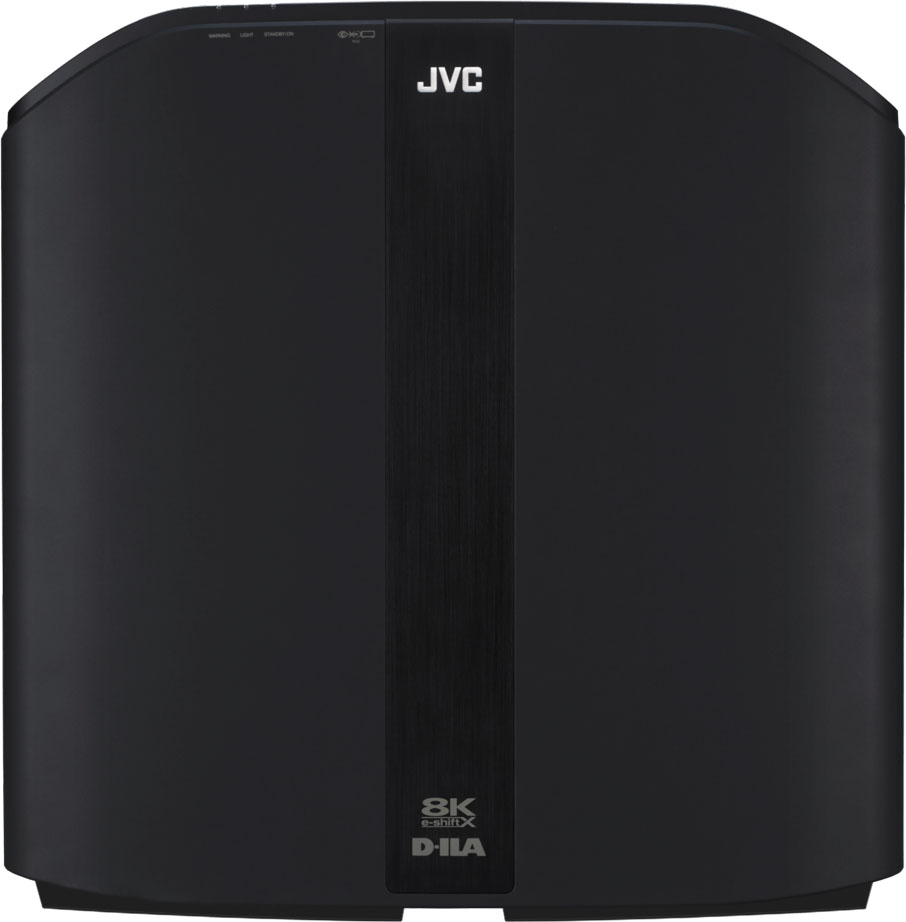
When it comes to 3D there are no changes compared to its predecessors, which may be a good or a bad thing. The projector does offer support for 3D content for those who refuse to let this dying format go away. So if you have a 3D collection and still want to put it to good use the NZ8 can do that remarkably good. But as was the case in the NZ7, this is not without some minor issues.
And this happens because you will need to buy an extra 3D Synch Emitter in order to connect with the wireless 3D glasses that you also need to buy separately. With a price of $16,000 having to buy this extra dongle seems a puzzling design decision. Also while the projector can auto detect the 3D signal having no dedicated 3D mode can be a chore as you will need to use a custom made which can be a time consuming procedure.
But as was the case with the NZ7, if you turn a blind eye on these shortcomings the projector will reward you for its 3D performance. Brightness obviously takes a hit but the NZ8 was very solid here with great depth, accurate colors and almost no artifacts or crosstalk.
Color Coverage
While the NZ7 was lacking the cinema filter, JVC included it in the NZ8 and NZ9. As a result the NZ8 can cover a bigger percentage of the color spectrum making it essentially a Wide Color Gamut capable projector.
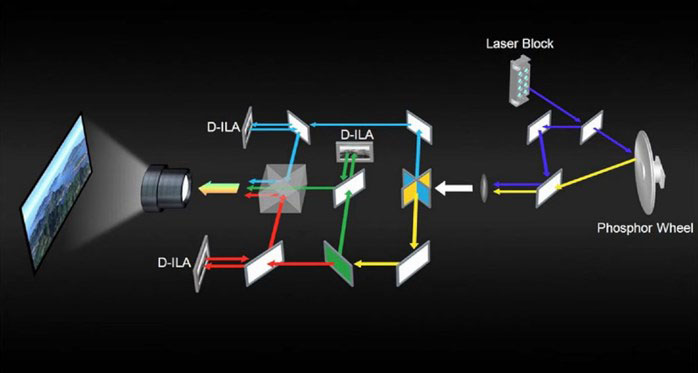
According to our measurements the projector could cover 96% of the DCI-P3 color space when the cinema filter was on which is extremely good. On the other hand when the cinema filter was off the NZ8 could cover 87% of the DCI-P3 which can still be considered very good but is notably lower than with it.
One thing that we need to mention here is the negative effect the cinema filter has on the projector’s brightness output. When in use, brightness will be lowered considerably so in essence you have to choose between better colors or higher brightness. We did some testing and in many cases the cinema filter lowered the overall brightness of the projector as much as 24% which is a lot.
Brightness / Picture Settings
The NZ8 is rated by JVC as a 2,500 lumens projector which is a notable improvement over the NZ7’s 2,200 lumens and this has to do with the fact that the NZ8 is using JVC’s ultra-high contrast optics which the NZ7 didn’t have.
Before we proceed with our measurements we should point out that there are 2 different picture modes to choose from that include Natural and Cinema along with some dedicated ones including HDR10/HLG, HDR10+, Frame Adapt HDR, Pana_PQ and Film with the last one being exclusive to the NZ8 and NZ9. There are also 6 user defined ones.
Once again there is no dedicated 3D mode, something that applies to the entire NZ series, so your best bet is to use a user defined mode in case you plan on using it for that.
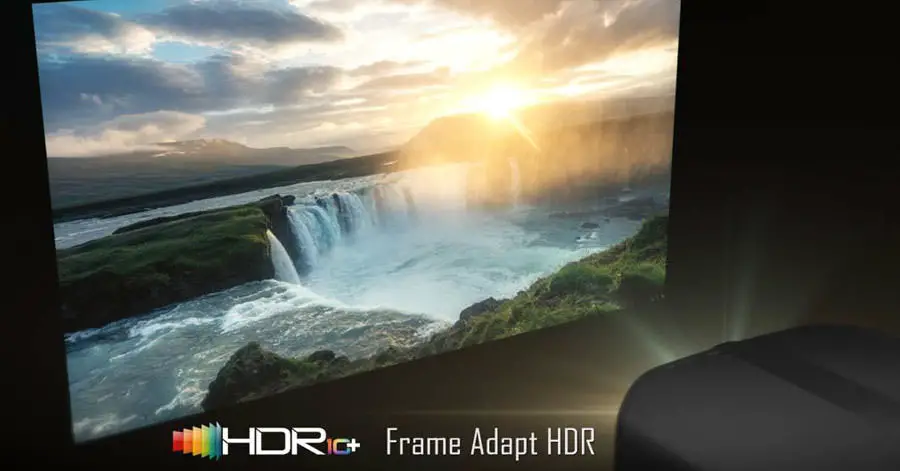
Also, as is the case in many other models, the HDR modes like HDR10 and HLG will auto switch when the projector detects the appropriate content being displayed.
One thing we mention all the time is that brightness measurements can vary greatly and they should not be taken as a given number. There are so many variables that can give you different brightness than what we get here in our testing, like different settings, light source hours and modes so our numbers should only be used as a reference and nothing more.
The DLA-NZ8’s out of the box performance was good but not great. In a way it reminded us what we saw in the NZ7 which offered respectable performance but in order to reach its full potential it needed some calibration. The same process was needed for the NZ8 and to be honest when you are ready to buy a $16,000 projector you are not going to go cheap on its calibration. So if you are not into such things hire a professional calibrator to do the job for you and the projector will really show you what it is capable of.
We used the laser setting in High for all our measurements and in SDR mode we got 2,038 lumens in Natural mode, 1,910 lumens in Cinema mode and 1,410 lumens in Film mode.

With HDR content most modes were really close to each other ranging from 1,945 lumens for the Pana_PQ mode up to 2,043 lumens for Frame Adapt HDR with the Frame by Frame setting.
The above results may not be close to the 2,500 lumens that the projector claims to be capable of but you can still get higher brightness if you use a user mode and calibrate the projector for high brightness output instead of color accuracy.
From all the above our preferred modes of use would be Natural for SDR content and Frame Adapt HDR with the Frame by Frame setting for all kinds of HDR videos. Obviously there are more settings you will need to change if you want to calibrate the projector properly but we usually avoid providing these as each projector can show different results and we strongly advise you to hire a calibrator that will set yours exactly as it should be.
Black Levels / Contrast
The NZ8 comes with a 80,000:1 native, which is a considerable boost over the 40,000:1 ratio of the NZ7, and a theoretical infinity:1 dynamic contrast ratio. As always never pay too much attention to these numbers as we have seen figures all over the place and in reality they don’t mean much since each brand uses different standards and conditions for their measurements.
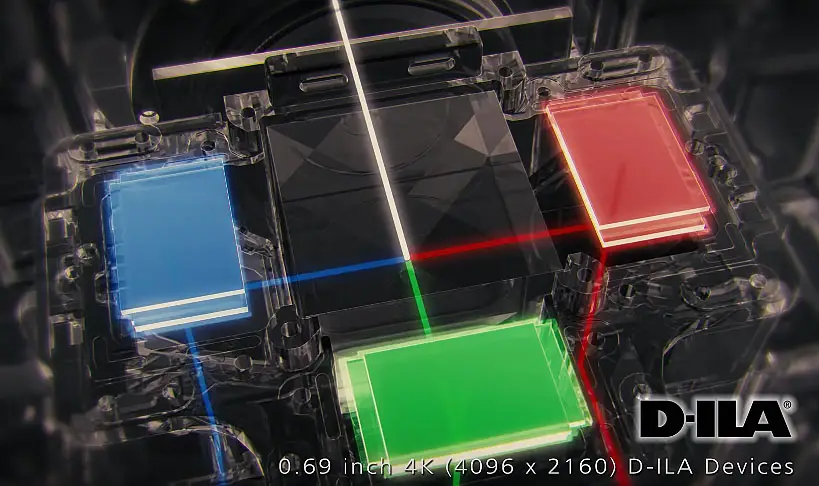
The projector does come with a feature called Dynamic Control which modulates the laser as needed in much the same way the company’s lamp projectors relied on a dynamic aperture to assist with black levels on dark scenes. You have the option to either turn it off or use it in Mode 1 or Mode 2 with the later being more aggressive while Mode 1 was the one we liked the most and the one we would suggest you choose.
The NZ8 did excellent here. Black colors and shadow details were amazing and there is a huge difference between what we see here and these low cost DLP units that project more grey-ish blacks than true deep blacks. The premium price you pay here really shows and you are not going to regret it.
Input Lag
The projector is not meant to be used mainly for gaming but that doesn’t mean that it shouldn’t offer a good experience in this area. And with the inclusion of HDMI 2.1 ports which means that the projector can accept 4K@120Hz signals it is even more important to see how good the NZ8 can do here.
For this test we turned off the 8K e-shift feature so all output was in 4K resolution and used the available Low Latency mode for the best results possible. Keep in mind that when Low Latency in enabled certain features like Clear Motion Drive cannot be used.
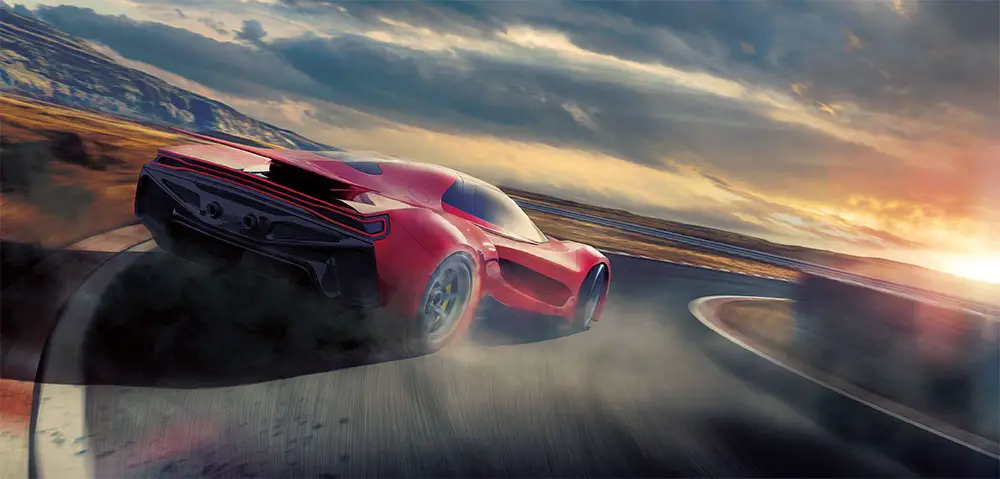
With these we measured a few different resolutions and refresh rates. At 1080p@60Hz we measured 38ms, at 1080p@120Hz 37ms, at 4K@60Hz 44.5ms and at 4K@120Hz 34.5ms.
The numbers above show that the NZ8 is really close in performance to the NZ7 and this comes as a no surprise as the two projectors share a lot of common hardware so there was no reason to behave differently.
The NZ8, along with the rest of the NZ series, is clearly not meant to be used as a gaming projector but the numbers above indicate that for slow paced offline gaming it will do great without any major problems. So if you are more or less a casual gamer that prefers to play offline then the NZ8 will have no problem to give you a very satisfying experience.
Motion Performance
When it comes to it’s motion performance the NZ8 comes with all the features and technologies we saw in the NZ7.
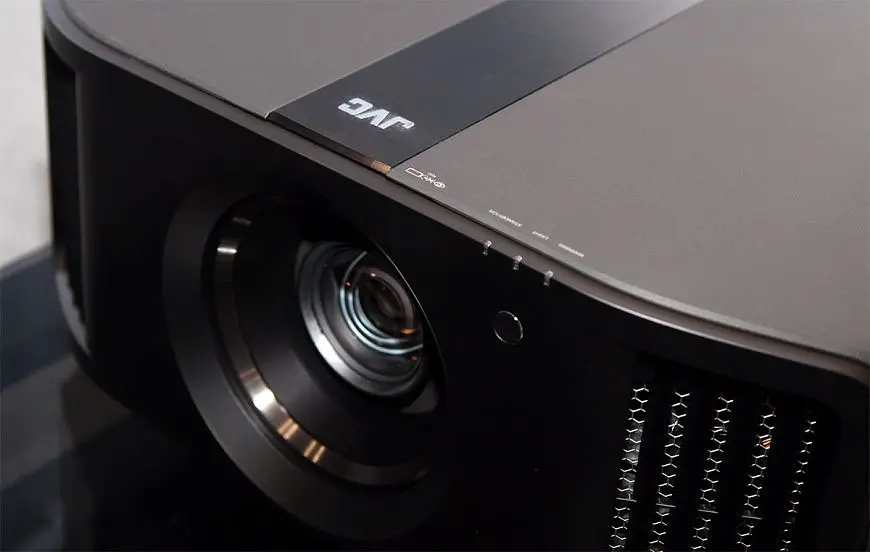
The projector uses the same motion interpolation software that JVC calls C.M.D. (Clear Motion Drive) in order to improve the image during fast camera panning. Another included feature is called Motion Enhance that works in parallel to the C.M.D. and is responsible at driving the D-ILA panels depending on the movement of the image and as a result we get less motion blur.
We tried both the Clear Motion Drive and Motion Enhance features in their low setting and we got very good results with them. Motion was great and retained its cinematic feeling without any excessive judder or motion blur that can be particularly bothering.
As always the higher the setting you use will make motion look unnatural and artificial which makes the Soap Opera Effect (SOE) appear. But a low setting can fix a lot of problems with low frame rate content.
Ports and Connectivity
The NZ8 is like for like with the NZ7 in terms of ports and connectivity options so nothing different to report.
All the ports are placed at the top left corner of the back side and what we get is a 3D sync port that can be connected with JVC’s separate PK-EM2 3D Synchro Emitter in order to communicate through a wireless connection with the PK-AG3 3D glasses. Next there are a couple of HDMI ports, an RS-232C port for command and control, a USB port that can be used only for firmware upgrades, an Ethernet port for wired internet connection and lastly a 12V trigger that can be connected to a motorized screen.
The major difference in the NZ8, that is characteristic in all new NZ projectors, is the updated HDMI ports it comes with. While the previous NX lineup was using ports that were capable of only 18Gbps of bandwidth the new NZ8 comes with HDMI 2.1/HDCP 2.3 ports capable of full 48Gbps bandwidth in order to support signals up to 8K@60Hz or 4K@120Hz. The only downside is that these do not support gaming centric features like ALLM or VRR.
But even so the NZ8 can be an excellent choice for both movies and gaming including the latest consoles that support up to 4K@120Hz signals.
OS, Apps and Features
In terms of extras and features the NZ8 is very similar to the NZ7 so this part of our review will reflect what we saw in JVC’s NZ7. Most of the menus and a major part of its settings selection are the same which was to be expected.
Setup is straightforward as the manual provide very details instructions on how to connect and calibrate everything so even if you have little idea what to do you shouldn’t have any major problems. The four adjustable feet will help you balance the projector straight while there is keystone correction and very generous lens shift in order to bring the image to it’s correct position. As always use keystone only in case of extreme need as using it always lowers image quality.
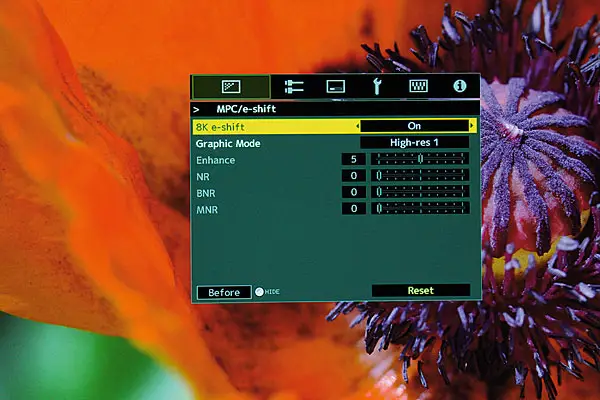
After powering up the projector we entered the familiar main menu which is divided in 6 different categories that include settings depending their function. The ones we get are Picture Adjust, Input Signal, Installation, Display Setup, Function and Information. The NZ8 has a few more picture settings than the NZ7 but everything else is the same.
Most JVC projectors were known for offering extensive image settings control and the NZ8 is no different as it comes with most features that were available in its predecessors. One of them is the Multiple Pixel Control (MPC) image processor while there is also a six-axis color management system. Another nice feature is Installation Mode that allow you to group save settings that include Lens Control, Pixel Adjustments, Screen Adjustments, Mask, Anamorphic Stretch Modes and Aspect Ratios. This is different from Lens Memories that allow you to save specifically image settings.
Also worth mentioning is the Auto Calibration Function that makes the NZ8 capable of optimizing various aspects of the image like gamma, color space, greyscale or color tracking by using an optical sensor and JVC’s exclusive software that are provided separately. Also included is ISF C3 (Certified Calibration Controls) mode while a fan favorite is its ability to display the MaxCLL and MaxFALL mastering data available for HDR content on some UHD Blu-ray discs.

Final Thoughts
Let’s be honest here. A $16,000 projector is not for everyone no matter how you see it. The JVC DLA-NZ8 is a premium top tier projector that is meant for those that seek top quality in their home theater system. And if you are wondering what is better to go for…the NZ7 or the NZ8, our answer to that is the following.
For about $6,000 more you get better brightness, better contrast, e-shiftX which can deliver an 8K image resolution and better colors due to the projector’s support for Wide Color Gamut. Everything else is practically the same. Are these enough for the extra price? That’s really up to you to decide.
As for the NZ8 in particular the projector can deliver an amazing cinematic experience with beautiful 4K images, lifelike colors, deep blacks and smooth motion. HDR performance was great with breathtaking bright highlights while it comes with plenty of image settings to calibrate it exactly as you like. Lastly the inclusion of HDMI 2.1 makes the unit future proof as it can accept up to 8K@60Hz signals with its full bandwidth ports.
As for its downsides, peak brightness takes a hit if you use the cinema filter so in essence you have to choose between higher color accuracy or higher brightness. Out-of-the-box performance is not the best and you need to spend some time calibrating it in order to reach its full potential. The projector is a bit louder than what we would like, it is missing a few HDMI 2.1 features like ALLM and VRR while its price is certainly out of range for most casual consumers.
We have reached the end of our review and to sum everything up we can say this. We were impressed by the quality of the NZ7 before but the JVC DLA-NZ8 proved to us that things can look even better. This is one mighty expensive projector but if you decide to go for it, its quality will really payoff and will make you a really happy owner. Highly recommended.

For more reviews you can check our dedicated 8K Projector reviews list or even look at our Product Reviews Table where you can find the brand and specific product you are looking for.
Cheapest Places to Buy :
*We are a reader-supported website. When you buy through links on our site, we may earn a small affiliate commission at no extra cost to you. Home Media Entertainment does not accept money for reviews.*
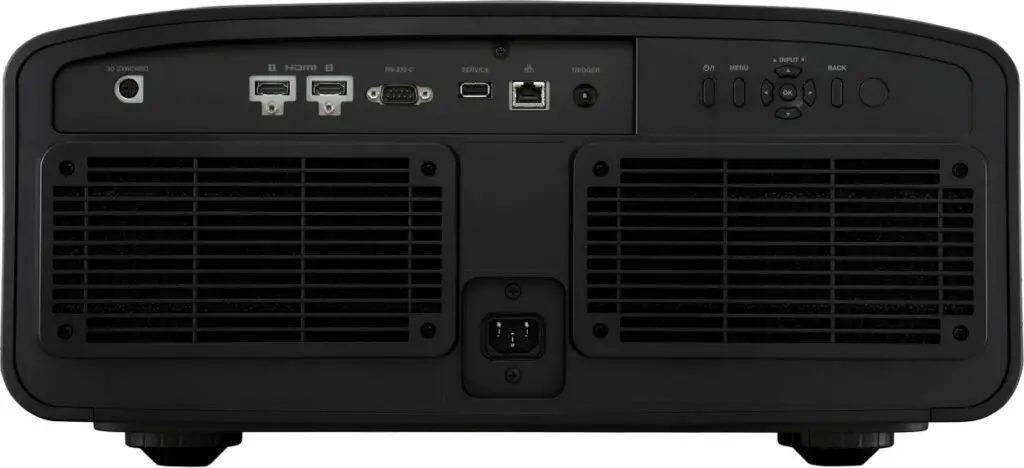
Thank you so much for this review of the JVC DLA-NZ8. I have been eyeing JVC’s projectors for a long time but this year I may finally make my move for one of them. Unfortunately the NZ8 is way out of my league. I will probably go for the NX5 as my budget cannot go any higher.
Hey there. Obviously this is not for everyone. JVC makes exceptional projectors but for a very specific market. There are other brands for the more casual friendly market.
Hi… I am an avid home theater person and came across your article and review of the NZ8. I just recently bought a new home with a dedicated home theater room. I was looking to see what kind of projector I should get, my brother has the NX7 which has a great picture, so I was thinking of going for this one. Its price is surely a bit high but I don’t plan on changing it for a few good years so I think it is worth it.
-Mike
Hello Mike. Surely with a price tag of $16,000 this is not for everyone. But its quality and performance really make up for it.
Hello,
I purchased JVC RS 2000 3 years ago. Recently, I notice dimmer picture overall, specially in HDR (lamp hrs=1500). Upon some research, I learnt that RS 2000 barely makes it for 4K resolution from a 16.6 ft throw distance (screen Nits=60).
So, I am leaning to get a NZ8 (NZ7 would be the same story).
Your comment would be appreciated.
Hey there. The NZ8 is surely an update over the NX7. And its higher brightness and laser based light engine will surely help in your situation. Is it worth the price? Well, given that you seem to have problems with the NX7 I would say yes but for such a price I would strongly suggest you try it out first just to be on the safe side that it satisfies you.
Great review! I just replaced my Epson 6050 with a JVC NZ8 and couldn’t be happier., even without further calibration. The Epson was good but the JVC is unworldly good, which is exactly what I wanted in what will likely be my last projector. I initially planned to purchase the NZ7 but felt the increased contrast and lumens of the NZ8 were compromises I wasn’t willing to make.
Great choice John. A really amazing projector worthy of its price tag.
I had a Nx5 and now I have the chance to own a Nz8. I can say that Nz8 is far far better than the Nx5 especially on brightness AND contrast (which is absolutely outstanding on this new laser line – you have the blacks of the x7900).
The picture quality is incredible, absolutely love it
Hello Morrocky. I am glad you like the NZ8. It is a really amazing projector. Have fun with it!!!